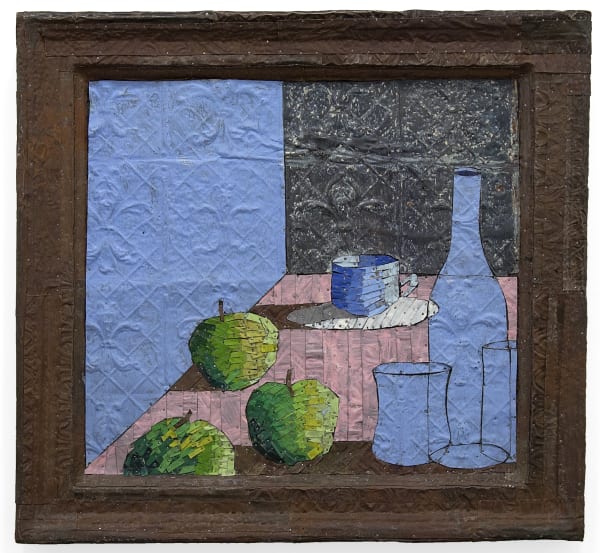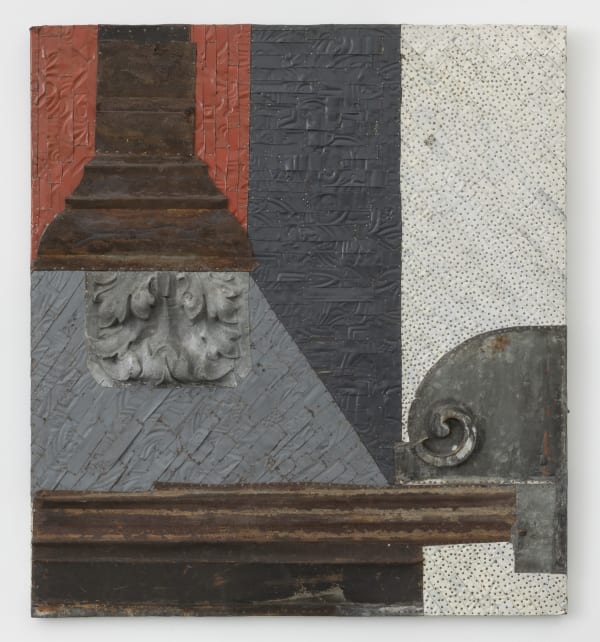-
ROBERT KOBAYASHI
MOE'S MEAT MARKET | SUSAN INGLETT GALLERY -
Photo: Adam Reich
-

ROBERT KOBAYASHI, MAQUETTE OF MOE'S MEAT MARKET
-
Kobayashi drew his energy and materials from the streets of Little Italy developing a unique style of mixed media dubbed by writer Michael Florescu, clouage, taken from the French verb “to nail.” Using found metals and detritus, he cobbled together 2 and 3-D works from discarded ceiling tin as well as beer and Cafe Bustelo cans. Through bricolage, he depicts intimate moments from the surrounding neighborhood. In Summer Window (2010), a nearly empty room features a singular vanity next to a window with a verdant view. Sculptures of fresh flowers in vases, like those from the flower markets in Little Italy, connect with his metal still-lifes of glasses and fruit on tabletops. These neglected materials and forgotten everyday city sights are elevated by Kobayashi’s distinctive touch.
Beyond these quotidian scenes, Kobayashi draws the eye back to the found materials so central to and characteristic of his work. The hammered surface of the tin tiles gives his pieces an almost pointillist appearance. From a distance, the raised nails and the geometric placement of the metalwork create an abstract pattern to be admired as an object unto itself. His sourced materials and subject matter result in examples that are emblematic of both the artist and his surroundings. Although Moe’s Meat Market closed in 2017, two years following Kobayashi’s death, the vibrant energy and memory of the gallery live on through his work. As Elizabeth Street now bustles with high-end, trendy shops, Kobayashi’s art embodies a bygone era of Little Italy, a poignant reminder in the present day of New York’s ever-evolving cultural landscape.
Banner Photo: Paul Glanders -

Robert Kobayashi (right) and Kate Keller Kobayashi (second from right) celebrate with friends the day they purchased the building that housed Moe's Meat Market, 21 July 1977. Photo: Dave Allison
-
-

Kobayashi with Mary Albanese, long-time resident of 237 Elizabeth Street who co-owned the butcher shop across the street with her son, September 1979
Photos: Kate Keller Kobayashi
-

Interior of Moe's Meat Market, late 1970s-early 1980s
-

Kobayashi with Valentine's Day window decorations, c. 1983
-

Kobayashi with his daughter, Misa (center), at Moe's Meat Market, 1990
-
-

Robert Kobayashi, Big Deal, 1980
-
-
Kobayashi's approach to mixed-media emphasized texture and materiality amplified by patterning. His characteristic tin strips run strategically across the works' surface to create direction— for example, on Kobayashi's busts, the tin recreates lines on the subjects' faces and clothing. For Fumiko in the Wind (2009), the artist uses both nail heads and exposed nail holes to build facial features, stamping out her lips and mouth in a pointillist pattern. The tiny nails, the hammered surfaces, and the placement of the tin form abstract patterns to be admired aside from their subject. In these works, Kobayashi underscores the importance of material— the artist's hand, as well as the tin's origins, is prominent, reminding the viewer that these works are an echo of both Kobayashi and his beloved Little Italy.
-
IONIC ORDER
-
Kobayashi's inventive treatment of found materials moves from two to three dimensions in his Ionic Order series. Here the artist makes use of the raised patterning found on tin ceiling tiles to suggest the capitals of Ionic columns, fully deploying the textural qualities of his bricolage technique.
While the act of creation was indeed a solitary affair, the lead up to its making was not. According to Kate Keller Kobayashi, "neighbors who knew that he used the found material for his work would anonymously drop off their tin dumpster finds in front of the store-door. Fragments of Little Italy itself were woven into Kobi’s artwork, figuratively and literally."
-
NUDES
-
A series of nudes from the late 1990s continues Kobayashi's enhanced use of the inherent properties of his ceiling tiles. Here, he treats the original raised ornamentation as wallpaper. In both White Sheet (1997) and Green Wallpaper (1998), the fleur-de-lis patterns are left intact and painted seafoam green. The simple illusion drives focus to the nude subject crafted from many wavering strips of tin, each colored with peach or white paint and cut to mimic the curves of the female body.
-
Still-lifes were a popular subject for Kobayashi, elevating the everyday through his clouage technique. Using a striking array of blues and greens, the artist treats his metallic strips as if they were wide brushstrokes, creating form and dimension through gradient and pattern. Glasses of water shift from navy to sky blue while apples and pears glisten in the sunlight in a muted chartreuse. Much like the discarded material used to create these bricolage works, Kobayashi reminds the viewer of the beauty in daily life and offers the opportunity to slow down and enjoy these oft overlooked scenes.
-
It was through the efforts of Phyllis Stigliano [former curator, Nassau County Museum of Art] that Moe’s Meat Market finally became Moe’s Meat Market, a gallery. In 2000 she suggested we start mounting shows of Kobi’s metal pieces, which by then had developed into a large body of work. From that point until 2008, Phyllis periodically mounted shows in the middle room of recently finished work [...] The gallery was open mostly by appointment and by happenstance, if Kobi had the door open or someone knocked loudly enough. With the gentrification of the neighborhood, there came a surge in tourism which brought more and more who, curious to see inside, wandered in off the street, first passing through Kobi’s studio to view the shows installed in the middle room. [...] We decided to take over the [back] room for art storage, an office, and a party space. It became the gathering place for Thanksgivings, Christmases, countless birthdays, and many gallery openings.
- Kate Keller Kobayashi
-
AFTER 9/11
-
Following September 11, Kobayashi began a new series of "grass" works, in which the artist built up the surface of the panel with dynamic green blades of painted tin and mixed metal. Collaged imagery, such as a wagon wheel and gate, materialized within these metallic fields. In contrast to the metropolis in mourning, Kobayashi's series provided a pensive escape to an imagined bucolic oasis beyond city limits.
-
LATE WORK
-
By 2009 the building was no longer taking the lion’s share of Kobi’s energy, giving him more time for his art. With this newfound freedom of time and the acknowledgment he felt from those who were visiting the gallery and elsewhere, going back upstairs to a smaller studio both challenged and encouraged him to push his vision further. At times, he referenced details or ideas from older works while something new was explored in each of the numerous works he produced the last five years he had his studio at 237.
- Kate Keller Kobayashi
-
-
CLOSING OF MOE'S MEAT MARKET
-
“The End of Moe’s Meat Market,” written by Jeremiah Moss in The New York Times, announced Moe’s Meat Market had closed its door at 237 Elizabeth Street on October 7, 2017, with a party. Once again, the backroom of Moe’s served as the gathering place for the many friends, neighbors, and family members, this time, for a celebratory toast to the gallery and its resident artist.
- Kate Keller Kobayashi
-

Kobayashi at Moe's Meat Market, c. 1978-79. Photo: Kate Keller Kobayashi
ROBERT KOBAYASHI: Moe's Meat Market
Past viewing_room

































